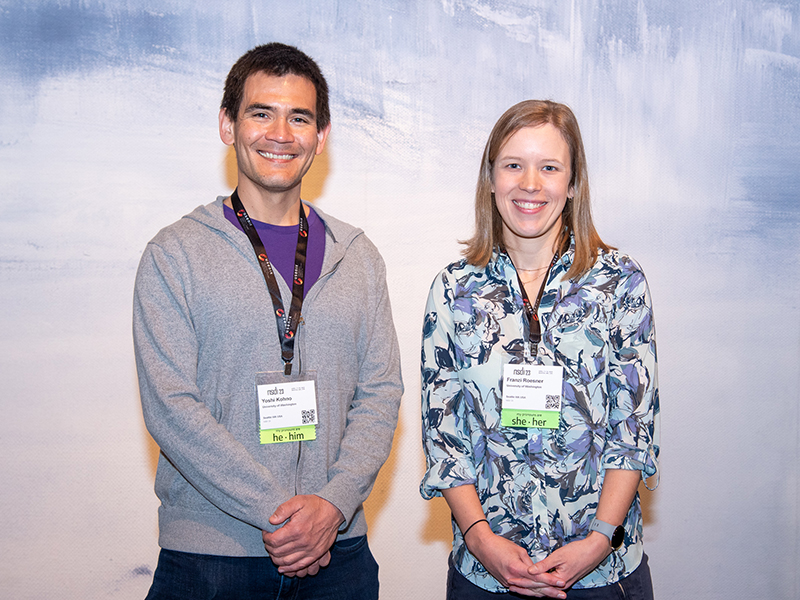There was a time when cookies were considered something to be savored — back when chips referred to chocolate rather than silicon. Once “cookies” became synonymous with online tracking, privacy researchers weren’t so sweet on the concept.
That includes Allen School professors Franziska Roesner and Tadayoshi Kohno, who investigated the online tracking ecosystem for their 2012 paper “Detecting and Defending Against Third-Party Tracking on the Web.” Last month, Roesner, Kohno and co-author David Wetherall, a former Allen School professor who is now a Distinguished Engineer at Google, received the Test of Time Award at the 20th USENIX Symposium on Networked Systems Design and Implementation (NSDI 2023) for their influential work, which offered the first comprehensive evaluation of third-party trackers and their intrusion into people’s activities online.
The team’s findings informed the nascent policy debate around web privacy that has become all the more relevant with the proliferation of social media and reliance on targeted advertising as a revenue model. They also led to the creation of new tools like Privacy Badger, a browser extension that learns and automatically blocks hidden third-party trackers used by millions of people to protect themselves and their browsing histories online. The work also inspired a significant body of follow-on research, including team members’ subsequent paper that appeared at NSDI 2016 chronicling the increase in both the prevalence of online tracking and the complexity of tracker behavior over time.
“Considering how much time we spend online and the variety of activities we engage in, this type of tracking can yield a lot of information about a person,” said Roesner, a co-director of the Security and Privacy Research Lab at the University of Washington along with Kohno. “That’s even truer today than it was a decade ago, and I’m gratified that our work helped initiate such an important conversation and informed efforts to educate and empower users.”
At the time of the original paper’s release, third-party tracking had started to gain attention in security and privacy circles. But researchers were just nibbling around the edges, for the most part; they had a fragmented understanding of how such trackers worked and their impact on people’s online experience. Roesner — an Allen School Ph.D. student at the time — worked with Kohno and Wetherall to develop a client-side method for detecting and classifying trackers according to how they interact with the browser. They analyzed tracker prevalence and behavior on the top 500 website domains, as identified by the now-defunct web traffic analysis firm Alexa Internet, examining more than 2,000 unique pages.
“We identified 524 unique trackers, some of which had sufficient penetration across popular websites to enable them to capture a significant fraction of a user’s browsing activity — typically around 20%, and in one case, as much as 66%,” Roesner recalled.
Roesner and her colleagues cataloged five types of tracker behavior, varying from the relatively benign, to the opportunistic, to the infuriating. The behaviors spanned analytics that are generally confined to a specific site, Google Analytics being an example; “vanilla” trackers, which rely on third-party storage to track users across sites for the purposes of additional analytics or targeted advertising, such as Doubleclick; forced, which include the dreaded popup or redirect that compels the user to visit its domain; referred, which rely on unique identifiers leaked by other trackers; and personal trackers, which engage in cross-site tracking based on a user’s voluntary visit to its domain in other contexts. Some trackers exhibit a combination of the above.
Despite the existence of multiple tools intended to give users more control, from third-party cookie blockers to “private” browsing mode, the team found those options insufficient for preventing certain trackers from following people across the web while maintaining any semblance of functionality. This was particularly true for popular social widgets by the likes of Facebook, Twitter, LinkedIn, Digg, and others that were embedded on a growing number of sites ranging from news outlets to online storefronts.
“While users could prevent some tracking, that was not the case for social widgets,” noted Roesner. “If a user was logged into a social media site like Facebook, for instance, their activity elsewhere on the web would be tracked — non-anonymously, I would add — even if they didn’t interact with the ‘like’ button embedded on those sites.”
For those who would prefer to cover their tracks while continuing to enjoy the convenience of interacting with social widgets on their terms, Roesner and her collaborators developed ShareMeNot. The browser extension took a bite out of social widgets’ ability to construct browsing profiles of users by only allowing activation of third-party tracking cookies when a user explicitly interacted with the “like,” “share,” or other relevant buttons; if a user visited a site but did not click on the social widgets, ShareMeNot stripped the cookies from any third-party requests to those trackers.
The team worked with an undergraduate research assistant in the lab, Chris Rovillos (B.S., ‘14) to refine ShareMeNot following the paper’s initial publication and address instances of the trackers attempting to circumvent the restrictions on cookies via other means. Instead of just blocking cookies, the new and improved version of the tool blocked tracker buttons altogether. In their place, ShareMeNot inserted local, stand-in versions of the buttons that users could click to either “like” a page directly or load the real button — putting users, not the trackers, in control. Roesner partnered with the nonprofit Electronic Frontier Foundation to incorporate ShareMeNot into the previously mentioned Privacy Badger, which remains an important tool for protecting users from intrusion by third-party trackers to this day.
The team’s work is notable for inspiring not only new technologies but also a new wave of researchers to focus on web tracking. One of those researchers, Umar Iqbal, followed that inspiration all the way to the Allen School.
“This is one of the seminal works in the space of web privacy and security. It had an immense influence on the community, including my own research,” observed Iqbar, a postdoc in the Security and Privacy Research Lab. “I extended several of the techniques proposed in the paper as part of my own doctoral thesis, from the measurement of online trackers, to their characterization, to building defenses. It was, in fact, one of the reasons I decided to pursue a postdoc with Franzi at UW!”
Roesner, Kohno and Wetherall were formally recognized at NSDI 2023 last month in Boston, Massachusetts. Read the research paper here.



